Unlike most of its relatives in the thread-waisted wasp family (Sphecidae), which nest in excavated underground burrows, the grass-carrying wasp prefers to nest aboveground in a preexisting cavity. These gentle, solitary wasps are common in July and August, visiting a variety of flowering native plants. Females collect tree crickets and grass blades in our gardens and landscapes to provide food and a safe, comfortable nursery in the chosen cavity where their larvae will grow and develop.
Like other solitary wasps, these wasps aren’t aggressive and don’t defend their nests. By providing cavities in wood or hollow plant stems in your garden in spring, as well as some of their preferred forage plants, you’ll likely have these beautiful wasps visiting and nesting in your garden next season.
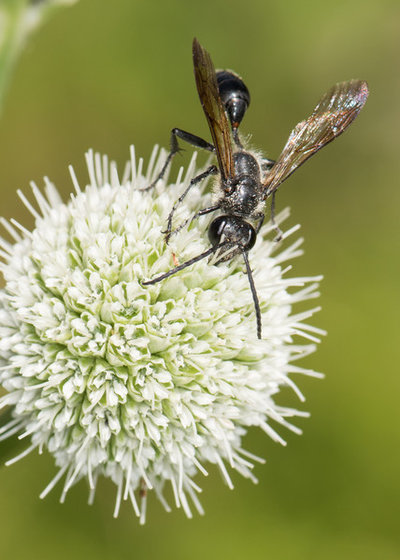
Holm Design & Consulting LLC
Family: Sphecidae (thread-waisted wasps)
Latin name: Isodontia mexicanaCommon name: Grass-carrying wasp
Distribution: North America east of the Rocky Mountains, including southern Canada southward to Central America
Habitat: Woodland edges, gardens, meadows, prairies, old fields and farms; nests between screens and windows where there is an accessible opening
When to look for them: In the northern United States, early July is often when the first sightings of adult wasps occur (earlier farther south); nest construction and provisioning begin in July. Following these initial tasks, adults can be observed visiting flowers in mid- to late July through early September.
Shown: An adult visits rattlesnake master (
Eryngium yuccifolium).
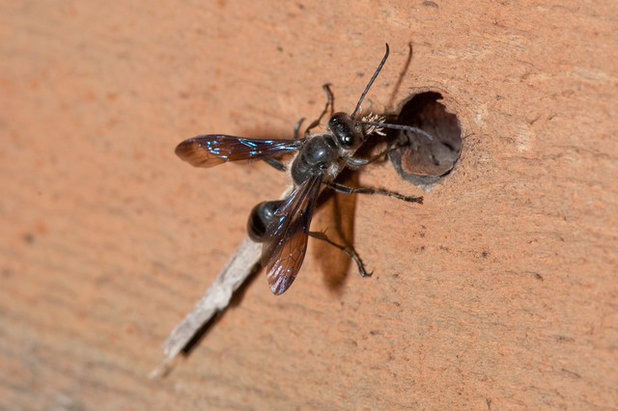
Holm Design & Consulting LLC
How They HelpGrass-carrying wasps are predatory, solitary wasps. Females hunt prey belonging to the insect family Gryllidae, usually tree crickets in the genus
Oecanthus.
Besides hunting these herbivorous prey, adults also visit a variety of flowering plants for nectar and can be considered pollinators in some cases. Like other solitary thread-waisted wasps, these wasps often demonstrate a preference for plants with white flowers. Nectar from flowering plants provides energy for the adults, especially females establishing nests and hunting for prey.
Shown: A female returns to her nest in a board with a piece of wood mulch fiber to use as a nest division or closure.
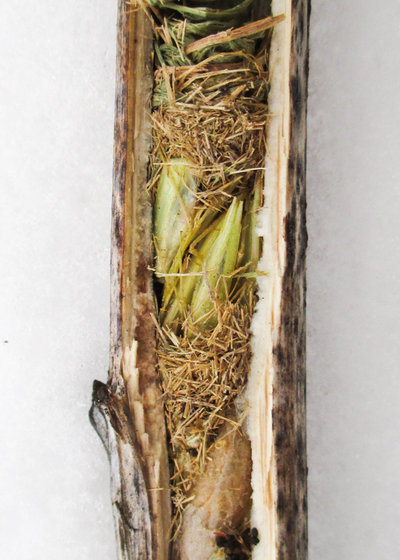
Holm Design & Consulting LLC
How to Spot Grass-Carrying WaspsAdults: Like others in the Sphecidae family, grass-carrying wasps have a very narrow section (thread waist) connecting their abdomen to their thorax. They’re medium-size, with a black head, thorax and abdomen. The wings are medium brown with a blue iridescent sheen. The thorax is covered in fine white hairs. Grass-carrying wasps are about 0.7 inches (18 millimeters) long.
Babies (larvae): Larvae are cream-colored, legless and develop within the nesting cavity, feeding on prey provided by their mother.
Shown: A cross section of a nest in a hollow plant stem shows cached tree crickets (light green), a cocoon spun by the larva and grass blades deposited by the mother to create divisions within the nest.
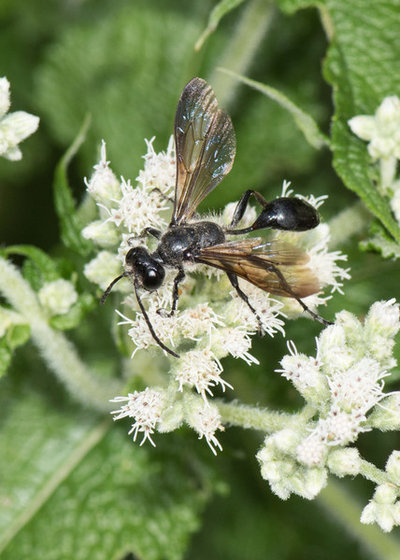
Holm Design & Consulting LLC
How to Lure ThemProvide a nesting place. Besides a continuous succession of flowering plants, these wasps need a preexisting cavity, such as a hollow plant stem or hole in wood. You can attract them by cutting hollow stems in 10-inch lengths and placing the stems horizontally aboveground, bundled together with burlap twine or in an open-ended container.
If the wasps are nesting where you don’t want them, such as behind storm windows, make sure you seal any access holes to prevent entry.
Maintain a pesticide-free yard. Don’t use pesticides, especially insecticides, in the garden, particularly on flowering plants.
Shown: A grass-carrying wasp forages on common boneset (
Eupatorium perfoliatum).
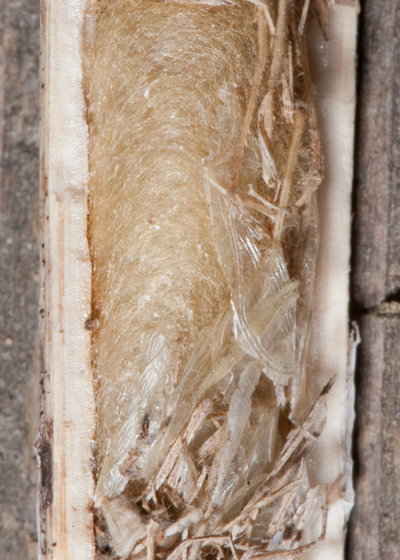
Holm Design & Consulting LLC
Offer forage plants and nesting materials for adults. Nest initiation begins in mid-July. Once the wasps have found a suitable site in a cavity, they begin gathering nesting materials before they cache the first prey.
Female grass-carrying wasps typically use pieces of grass to line their nests and make divisions inside the cavity for the developing larvae. Using her mandibles, the female wasp cuts a grass blade, then flies back to her nest carrying it in her mandibles. These wasps are often spotted by gardeners as they fly toward their nest carrying grass blades. They coil the blades to form partitions or plug the end of the cavity.
Once some nest provisioning has occurred, the adults can be observed visiting flowers for nectar in late July through early September.
Sample plant list for adults:- Summer: American spikenard (Aralia racemosa), common boneset (Eupatorium perfoliatum), Virginia mountain mint (Pycnanthemum virginianum), rattlesnake master (Eryngium yuccifolium)
- Late summer and fall: Goldenrod (Solidago spp.)
Shown: A close-up of the nest shows the silken cocoon spun by the larva. Inside the cocoon, the larva will pupate.
Browse native plants for your region

Holm Design & Consulting LLC
Life cycle. After emerging from their natal nest, females mate with males and begin nest construction. Unlike the majority of Sphecid wasps, which nest in burrows below the ground, grass-carrying wasps usually select nesting sites aboveground in cavities, although they have been documented to use preexisting holes in the ground.
These wasps will either create and provision individual brood cells partitioned with blades of grass, or create a communal area where multiple larvae feed and develop. The female hunts high in tree canopies where her prey occur. She stings the victim to immobilize it; clutching the paralyzed prey underneath her, she then carries it back to the nest.
Once a nest is provisioned with enough prey, she lays an egg. These wasps can produce one or two generations per year in the upper Midwest and Northeast regions.
The larvae hatch in the following days and consume the cached prey for the next four to seven days. When the food provisions are entirely consumed, each larva spins a cocoon and overwinters in the cocoon in a prepupal or pupal state. Development continues the following spring with the wasps completing pupation or emerging as adults in July.
Shown: An adult visits stiff goldenrod (
Oligoneuron rigidum).
Region by region: What to do in your garden this month





